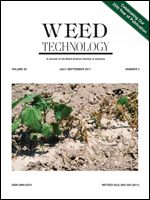Weeds are a major constraint to rice production in labor-limited, upland rice-based systems in West Africa. The effects of weeding regimes and rice cultivars on weed growth and rice yield were investigated at two upland locations (Abomey-Calavi and Niaouli) in the degraded coastal savanna zone of Benin in 2005 and 2006 with below-average rainfall. Four weeding regimes (hoe weeding at 21 d after sowing [DAS], delayed hoe weeding at 31 DAS, hoe weeding at 21 and 42 DAS, and a no weeding control) were the main plot treatments. Cultivars comprising three interspecific upland rice cultivars (NERICA 1, NERICA 2, and NERICA 7) and the parents (Oryza sativa WAB56-104 and O. glaberrima CG14) were tested in subplots. The most dominant weed species identified were Jamaican crabgrass, Mariscus, and silver spinach. Rice yield was generally low because of drought stress; none of the experiments had a higher mean yield than 1,400 kg ha−1 across cultivars. Across cultivars, the best weeding regimes in terms of weed control and rice yields were single weeding at 31 DAS (W31) and double weeding at 21 and 42 DAS (W21 42). Under these weeding regimes, WAB56-104 out-yielded the three NERICA cultivars. CG14 showed the strongest weed suppressive ability (WSA) in Abomey-Calavi but did not have strong WSA in Niaouli because of lower biomass accumulation. WSA of WAB56-104 was similar to that of the three NERICA cultivars. Single weeding at 31 DAS, together with the use of cultivars with good adaptation to unfavorable rice growing conditions, would increase land and labor productivity of upland rice-based systems in West Africa.
Nomenclature: Jamaican crabgrass, Digitaria horizontalis Willd.; Mariscus, Mariscus alternifolius Vahl.; silver spinach, Celosia trigyna L.; rice, Oryza glaberrima Steud ‘CG14’; rice, Oryza sativa Linn. ‘WAB56-104’; rice, O. sativa × O. glaberrima, NERICA 1 ‘WAB450-IBP-38-HB’; rice, O. sativa × O. glaberrima, NERICA 2 ‘WAB450-11-1-P-31-1’; rice, O. sativa × O. glaberrima, NERICA 7 ‘WAB450-IBP-20-HB’.





